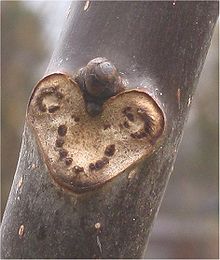Leaf scar

Leaf scars develop on the shoot axes of perennial plants after the leaves have fallen. They are particularly easy to spot immediately after the leaves have fallen. By transforming the outer cell layers into a later woody cutis tissue, the traces fade over time, but are usually visible over several years. If necessary, the top layer of cork can be carefully removed with a sharp blade to examine older scars. Since each species has specific leaf scars, these are next to the bud and barkan important feature for determining the species of woody plants in winter. They are always found below a bud. The leaf scars sit either flat on the branch or on a more or less strong swelling of the branch, which is also called a leaf cushion.
In addition to the outline, the position and number of vascular bundles (leaf traces or bundle features) are characteristic of leaf scars. The vascular bundles enable material to be transported between the leaf and the stem axis during the growing season. When the leaves fall off, they tear and are usually clearly visible in the form of dots or lines. With single-lane leaf scars only one vascular bundle is visible, with multi -lane leaf scars accordingly several.
Leaf scars, however, also often form an entry point for plant diseases , such as tree cancer (Nectria) or bacterial blight ( Pseudomonas mors-prunorum ) in the cherry.
literature
- Bernd Schulz: Pocket Atlas of Buds and Twigs. Identify 270 trees using color drawings. Ulmer, Stuttgart 2004, ISBN 3-8001-4601-0 .
- Ludwig Staby: About the closure of the leaf scars after the leaves have fallen off. Schade, Berlin 1885, (Berlin, Phil. Diss. 1885).
Web links
- Basics of woody identification in winter on unr.ch.